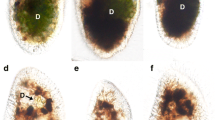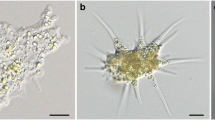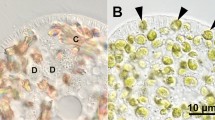Abstract
Each symbiotic Chlorella of the ciliate Paramecium bursaria is enclosed in a perialgal vacuole membrane derived from the host digestive vacuole membrane. Alga-free paramecia and symbiotic algae can grow independently. Mixing them experimentally can cause reinfection. Earlier, we reported that the symbiotic algae appear to push the host trichocysts aside to become fixed beneath the host cell cortex during the algal reinfection process. Indirect immunofluorescence microscopy with a monoclonal antibody against the trichocysts demonstrates that the trichocysts change their locality to form algal attachment sites and decrease their density beneath the host cell cortex through algal reinfection. Transmission electron microscopy to detect acid phosphatase activity showed that some trichocysts near the host cell cortex are digested by the host lysosomal fusion during algal reinfection. Removal of algae from the host cell using cycloheximide recovers the trichocyst's arrangement and number near the host cell cortex. These results indicate that symbiotic algae compete for their attachment sites with preexisting trichocysts and that the algae have the ability to ensure algal attachment sites beneath the host cell cortex.











Similar content being viewed by others
References
Adoutte A (1988) Exocytosis: biogenesis, transport and secretion of trichocysts. In: Görtz HD (ed) Paramecium. Springer, Berlin, pp 325–362
Dryl S (1959) Antigensic transformation in Paramecium aurelia after homologous antiserum treatment during autogamy and conjugation. J Protozool 6:25
Fujishima M, Nagahara K, Kojima Y (1990) Changes in morphology, buoyant density and protein composition in differentiation from the reproductive short form to the infectious long form of Holospora obtusa, a macronucleus-specific symbiont of the ciliate Paramecium caudatum. Zool Sci 7:849–860
Galfre G, Milstein C (1981) Preparation of monoclonal antibodies: strategies and procedures. Meth Enzymol 73:3–47
Gomori G (1952) Microscopic histochemistry. Principles and practice. University of Chicago Press, Chicago
Gu FK, Chen L, Ni B, Zhang X (2002) A comparative study of the electron microscopic enzymo-cytochemistry of Paramecium bursaria from light and dark cultures. Eur J Protistol 38:267–278
Harumoto T, Miyake A (1991) Defensive function of trichocysts in Paramecium. J Exp Zool 260:84–92
Hausmann (1978) Extrusive organelles in protists. In: Jeon K (ed) International Review of Cytology, Vol. 52. Elsevier, pp 197–276
Hausmann K, Hülsmann N, Radek R (2003) Protistology. 3rd completely revised edition. Schweizerbart’sche Verlagsbuchhandlung, Stuttgart, Germany
Karakashian MW (1975) Symbiosis in Paramecium bursaria. Symp Soc Exp Biol 29:145–173
Karakashian SJ, Rudzinska MA (1981) Inhibition of lysosomal fusion with symbiont-containing vacuoles in Paramecium bursaria. Exp Cell Res 131:387–393
Kodama Y, Fujishima M (2005) Symbiotic Chlorella sp. of the ciliate Paramecium do not prevent acidification and lysosomal fusion of the host digestive vacuoles during infection. Protoplasma 225:191–203
Kodama Y, Fujishima M (2007) Infectivity of Chlorella species for the ciliate Paramecium bursaria is not based on sugar residues of their cell wall components, but on their ability to localize beneath the host cell membrane after escaping from the host digestive vacuole in the early infection process. Protoplasma 231:55–63
Kodama Y, Fujishima M (2008) Cycloheximide induces synchronous swelling of perialgal vacuoles enclosing symbiotic Chlorella vulgaris in the ciliate Paramecium bursaria. Protist 159:483–494
Kodama Y, Fujishima M (2009a) Timing of perialgal vacuole membrane differentiation from digestive vacuole membrane in infection of symbiotic algae Chlorella vulgaris of the ciliate Paramecium bursaria. Protist 160:65–74
Kodama Y, Fujishima M (2009b) Localization of perialgal vacuoles beneath the host cell surface is not a prerequisite phenomenon for protection from the host’s lysosomal fusion in the ciliate Parameium bursaria. Protist 160:319–329
Kodama Y, Fujishima M (2009c) Infection process of symbiotic Chlorella species to Paramecium bursaria. In: Fujishima M (ed) Endosymbionts in Paramecium, Microbiology Monographs 12. Springer-Verlag, Berlin, pp 31–55
Kodama Y, Fujishima M (2010). Secondary symbiosis between Paramecium and Chlorella cells. In: Jeon K (ed) International Review of Cell and Molecular Biology, Vol. 279. Elsevier, pp 33–77
Kodama Y, Nakahara M, Fujishima M (2007) Symbiotic alga Chlorella vulgaris of ciliate Paramecium bursaria shows temporary resistance to host lysosomal enzymes during the early infection process. Protoplasma 230:61–67
Omura G, Suzaki T (2003) Changes in trichocysts during re-infection of white Paramecium bursaria by Chlorella. Jpn J Protozool 36:69–70 (in Japanese)
Pape R, Plattner H (1990) Secretory organelle docking at the cell membrane in Paramecium cells. Dedocking and synchronized redocking of trichocysts. Exp Cell Res 191:263–272
Plattner H, Westphal C, Tiggemann R (1982) Cytoskeleton-secretory vesicle interactions during the docking of secretory vesicles at the cell membrane in Paramecium tetraurelia cells. J Cell Biol 92:368–377
Reisser W (1986) Endosymbiotic associations of freshwater protozoa and algae. In: Corliss JO, Patterson DJ (eds) Progress in Protistology, Vol. 1. Biopress Bristol, pp 195–214
Reynolds ES (1963) The use of lead citrate at high pH as an electron-opaque stain in electron microscopy. J Cell Biol 17:208–212
Spurr AR (1969) A low viscosity epoxy resin embedding medium for electron microscopy. J Ultrastruct Res 26:31–43
Tonooka Y, Watanabe T (2002) A natural strain of Paramecium bursaria lacking symbiotic algae. Eur J Protistol 38:55–58
Acknowledgements
We thank Mr. Yoji Morifuku, the Center for Instrumental Analysis, Yamaguchi University, for his kind technical assistance in the use of the TEM CCD camera. This work was supported by a Japan Society for the Promotion of Science (JSPS) Research Fellowship for Young Scientists granted to Y. Kodama, and by a Narishige Zoological Science Award granted to M. Fujishima.
Conflicts of interest
The authors declare that they have no conflicts of interest.
Author information
Authors and Affiliations
Corresponding author
Additional information
Handling Editor: Reimer Stick
Rights and permissions
About this article
Cite this article
Kodama, Y., Fujishima, M. Endosymbiosis of Chlorella species to the ciliate Paramecium bursaria alters the distribution of the host’s trichocysts beneath the host cell cortex. Protoplasma 248, 325–337 (2011). https://doi.org/10.1007/s00709-010-0175-z
Received:
Accepted:
Published:
Issue Date:
DOI: https://doi.org/10.1007/s00709-010-0175-z




